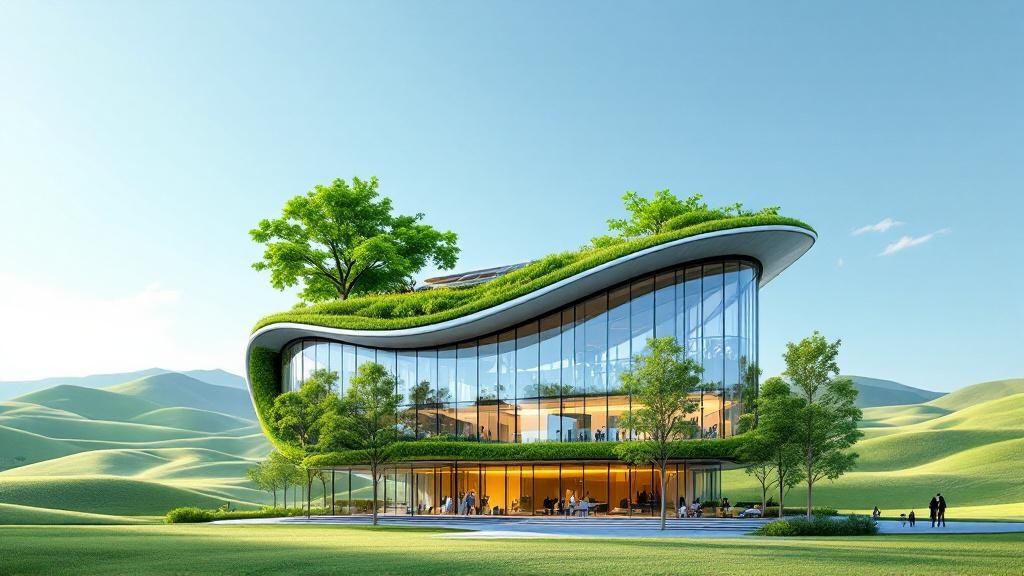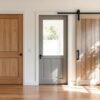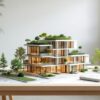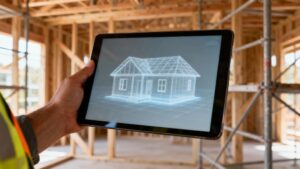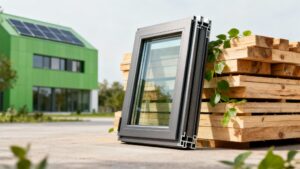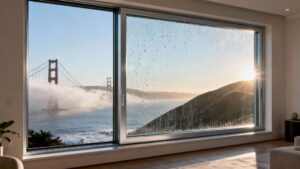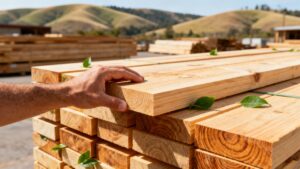When you hear the term “sustainable building,” what comes to mind? It’s more than a trend; it's a fundamental shift in how we approach creating healthier, more efficient structures that work in harmony with the environment.
This is a holistic philosophy. It forces us to look at a building's entire lifecycle—from design sketches and material choices to its day-to-day operation and eventual deconstruction. It’s about building smarter, not just harder, for builders, contractors, and homeowners alike.
Why Sustainable Building Matters Now More Than Ever in the Bay Area
Sustainable building has moved from a niche interest to a core practice, something professionals across the San Francisco Bay Area are increasingly prioritizing. It’s a direct response to global challenges like climate change and resource depletion. This isn't about just one feature, like adding solar panels; it's about an integrated system where every component works together to shrink our environmental impact.
The urgency is real. Globally, buildings account for nearly 40% of all energy consumption, according to the World Green Building Council, and roughly a third of greenhouse gas emissions. But sustainable practices have proven they can drastically lower these figures, with certified green buildings showing major cuts in both energy and water use. This makes it a crucial strategy for building resilient communities in Berkeley, Oakland, and the wider Bay Area.
Understanding a Building as a Complete System
The best way to think about a sustainable building is not as a static object, but as a living system. Every choice—from the R-value of the insulation to the placement of a window—impacts its overall performance.
The goal is to create a structure that:
- Minimizes Resource Consumption: Using less energy, water, and raw materials from day one.
- Maximizes Occupant Health: Intentionally improving indoor air quality and maximizing natural light.
- Reduces Environmental Footprint: Limiting waste, pollution, and disruption to the local ecosystem.
This mindset prioritizes long-term value and performance. For contractors in the Bay Area, this means building higher-quality homes that are more desirable to modern buyers. For homeowners, it translates directly into lower utility bills and a healthier living space.
A truly sustainable project is designed with its entire lifecycle in mind. It considers not just construction but also decades of operation and how its materials can be repurposed at the end of its life.
The table below breaks down the foundational pillars of this philosophy.
The Six Pillars of Sustainable Building Design
A quick look at the core concepts that define the sustainable building philosophy, from site planning to material selection.
| Pillar | Description |
|---|---|
| Site Planning & Design | Strategically using the building site to reduce environmental impact and improve energy efficiency. |
| Energy Efficiency | Minimizing energy use through high-performance insulation, efficient windows, and smart system design. |
| Water Conservation | Implementing strategies like low-flow fixtures and rainwater harvesting to reduce water consumption. |
| Material Selection | Choosing recycled, renewable, and locally sourced materials that are non-toxic and have a low carbon footprint. |
| Indoor Environmental Quality | Focusing on air quality, natural light, and thermal comfort to create a healthy indoor space for occupants. |
| Waste Reduction | Designing for minimal construction waste and planning for material reuse or recycling at the end of the building's life. |
These pillars aren't just abstract ideas; they are the building blocks for creating structures that are both responsible and resilient.
Local Relevance: Sustainable Building in the Bay Area
Here in the environmentally-conscious Bay Area, these principles are more than ideals—they are quickly becoming standard practice. This shift is driven by strong consumer demand and some of the nation's most stringent regulations, like California's Title 24 energy code.
For local builders, adopting these methods provides a clear competitive advantage and aligns with community values. Truitt & White is committed to providing the necessary green building materials and expertise to help you succeed. This approach ensures that what we build today contributes positively to our community's future.
The Five Core Principles of Green Building Design
Sustainable building is guided by a clear set of principles. Think of it as a practical roadmap that helps builders, architects, and homeowners make smart choices on any project, from a full-scale build in Oakland to a remodel in Berkeley.
These five pillars work together to create buildings that are more efficient, healthier, and lighter on the environment. Let's break down each one with real-world examples relevant to us here in the Bay Area.
1. Smart Site and Location Planning
The best green building practices start long before you hammer the first nail. Smart site and location planning is about developing a property to minimize its environmental footprint while taking full advantage of what nature provides.
A new build in the Bay Area should be positioned to work with the sun, not against it. By orienting windows to capture winter sun, you can dramatically cut heating costs. Add overhangs to block high summer sun, and your cooling needs will drop, too.
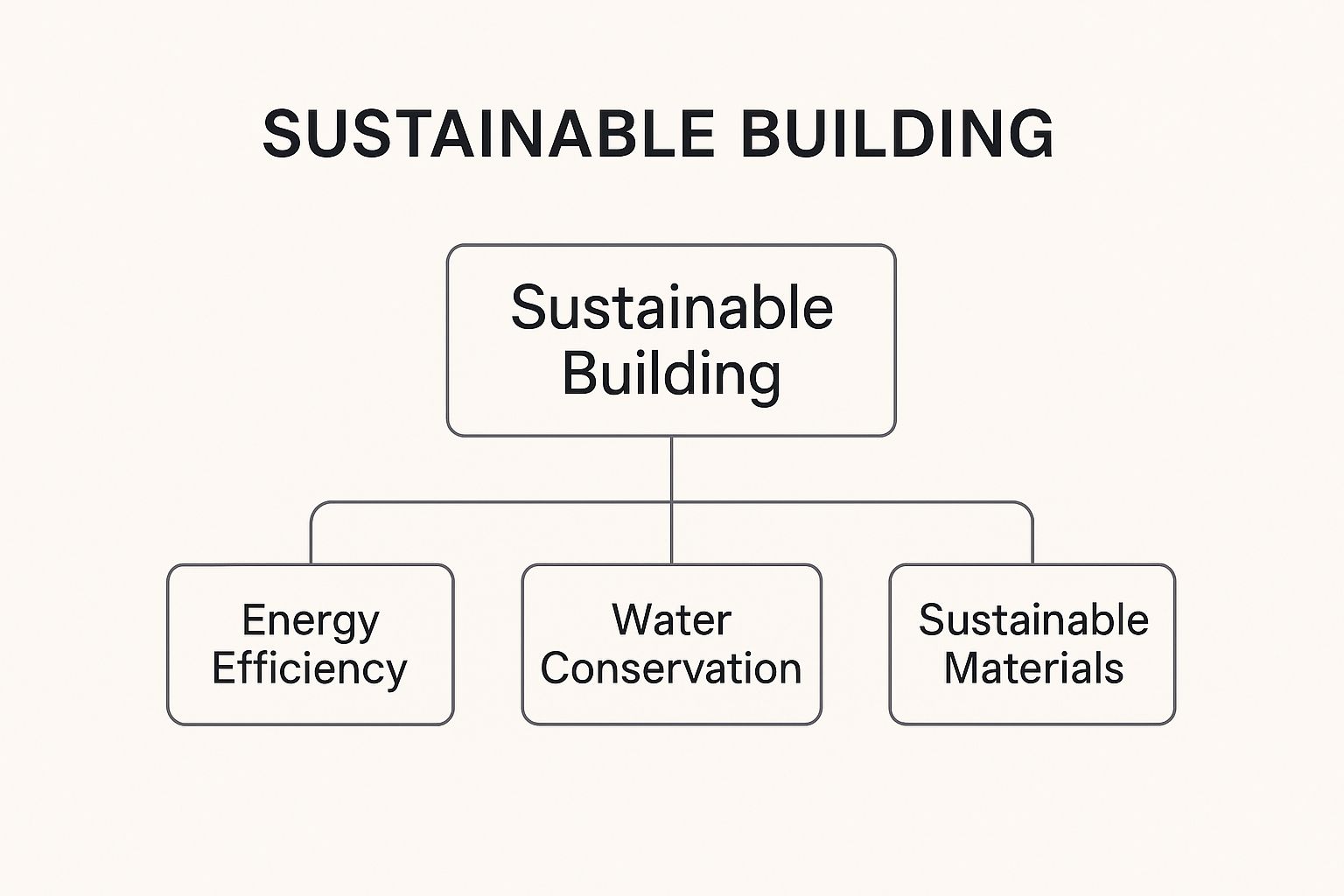
(Caption: This diagram shows how the core principles of sustainable building—energy, water, and materials—are interconnected to create a high-performance home.)
As you can see, it all comes back to being smart about energy, water, and materials.
2. Superior Energy Efficiency
Slashing a building's energy use is a cornerstone of sustainable design. The goal is to create a high-performance building envelope that works like a quality thermos, keeping the inside comfortable regardless of outside weather.
A few key strategies get you there:
- High-Performance Windows: Products from brands like Marvin and Andersen now feature double or triple panes, low-emissivity (Low-E) coatings, and insulated frames. They make a huge difference in stopping heat transfer.
- Advanced Insulation: Using materials with a high R-value in walls, attics, and floors is non-negotiable. Modern options like spray foam or dense-packed cellulose are fantastic at preventing energy leakage.
- Efficient HVAC Systems: Today’s heating, ventilation, and air conditioning systems are incredibly efficient. When paired with a well-sealed home, they run less often and work more effectively.
Funding opportunities are available, including renewable energy grants for installing systems like solar panels.
3. Strategic Water Conservation
Here in California, saving water is critical. Green building tackles water consumption both inside and outside the home, aiming to cut back usage and manage this precious resource responsibly.
Indoors, this means installing high-efficiency fixtures and appliances. Low-flow toilets and showerheads can reduce indoor water use by 30% or more, according to the EPA, without a noticeable difference in performance. Outside, it’s all about smart landscaping with native, drought-tolerant plants that thrive in the Bay Area climate.
4. Responsible Material Selection
The materials you choose have a massive impact on your project's sustainability. Responsible material selection means looking for products that are durable, non-toxic, and have a low environmental footprint across their entire life.
A building is only as sustainable as the materials it's made from. Focusing on recycled content, renewability, and local sourcing can dramatically lower a project's embodied carbon.
When picking out materials from a lumberyard near Oakland, think about these attributes:
- Recycled Content: Using products like recycled steel or composite decking reduces the demand for raw resources.
- Renewable Resources: Fast-growing materials like bamboo or FSC-certified lumber are better choices than finite resources.
- Local Sourcing: Choosing materials made closer to home—like from a Berkeley building materials supplier—cuts down on transportation emissions and supports our local economy.
5. Enhanced Indoor Environmental Quality (IEQ)
A green building should also be a healthy building. Indoor Environmental Quality (IEQ) is all about creating spaces that support the well-being of the people inside. This is a big deal, as the EPA estimates we spend about 90% of our time indoors.
Key elements for great IEQ include clean air, natural light, and comfortable temperatures. This is achieved by choosing low-VOC (volatile organic compound) paints, glues, and finishes. A good ventilation system brings in a constant supply of fresh, filtered air without wasting energy.
Choosing Eco-Friendly Building Materials for Bay Area Projects
This is where the rubber meets the road. Selecting the right materials is when a sustainable building concept becomes a physical reality. For builders in Berkeley or Oakland, your material choices impact the project's environmental footprint, durability, and occupant health.
It's about more than a "recycled" label. A truly eco-friendly material is judged by its entire lifecycle. Getting this right means less waste, smarter use of resources, and a better-built, more resilient structure.
From Traditional to Sustainable Materials
Look at any traditional building site, and you'll see common materials that now have greener alternatives. The aim is to prioritize materials that are renewable, recycled, and non-toxic.
Here are a few game-changers we see in Bay Area projects:
- Reclaimed Wood: Pulling lumber from old buildings saves new trees and adds character new materials can't match.
- Bamboo: Technically a grass, bamboo grows exceptionally fast, making it a fantastic renewable resource for flooring and cabinetry.
- Low-VOC Paints and Finishes: Volatile organic compounds (VOCs) harm indoor air quality. Choosing low- or zero-VOC products is a critical move for a healthier home.
- Recycled Steel: Using recycled steel for framing sidesteps the massive energy consumption of producing new steel.
As "green" becomes more popular, so does misleading marketing. Knowing how to avoid greenwashing is a crucial skill to ensure your choices are genuinely making a difference.
Innovative Building Systems for High-Performance Homes
It's not just about individual materials; entire building systems are evolving for superior performance. For us in California, they are a fantastic tool for meeting and exceeding the state's Title 24 energy standards.
Two of the most impactful systems we work with are:
- Structural Insulated Panels (SIPs): A high-tech sandwich of rigid foam insulation between two structural boards. Homes built with SIPs have an incredibly airtight envelope, which dramatically slashes heating and cooling bills.
- Insulated Concrete Forms (ICFs): Hollow foam blocks stacked like Legos and then filled with steel-reinforced concrete. The result is a structure with phenomenal strength and thermal mass that helps keep indoor temperatures stable.
For builders in the Bay Area, systems like SIPs and ICFs offer a direct path to superior energy performance. They reduce on-site labor and waste, delivering a high-quality building envelope that performs exceptionally well in our climate.
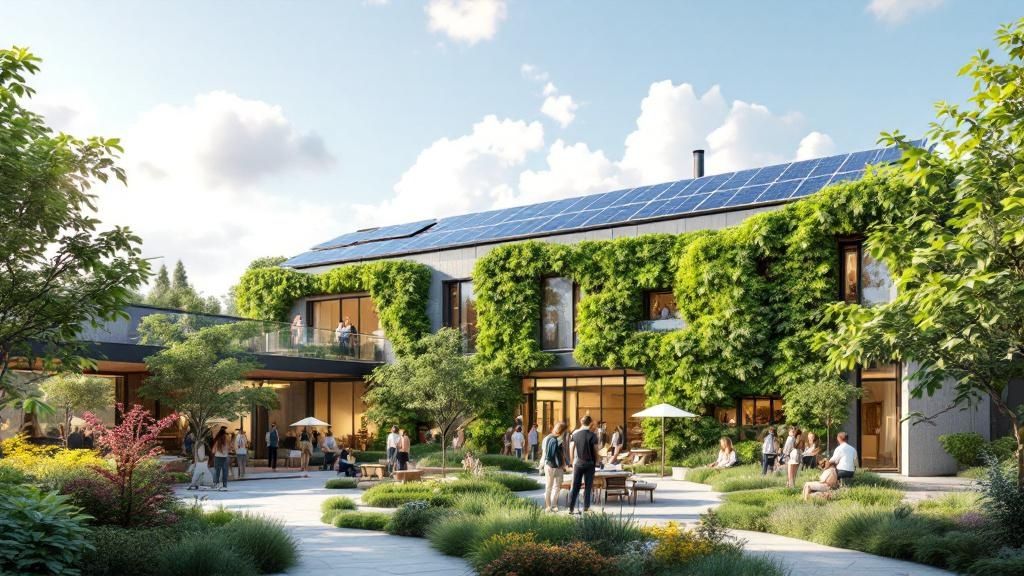
(Caption: A diagram illustrating the components of an energy-efficient wall system, a key element in sustainable construction.)
Comparing Popular Eco-Friendly Building Materials
This table is a quick-reference guide to help you compare some of the most popular materials for your next build. Of course, a table is just a starting point. To see these products and get expert advice, exploring a comprehensive inventory of building materials for the San Francisco Bay Area is the best next step.
A quick-reference guide comparing the benefits, best uses, and sustainability factors of popular green materials.
| Material | Primary Benefit | Best Use Case (Bay Area) | Sustainability Factor |
|---|---|---|---|
| Reclaimed Wood | Reduces waste; unique aesthetic | Feature walls, beams, flooring | High recycled content, diverts from landfill |
| Bamboo Flooring | Highly renewable and durable | Residential flooring, especially in modern homes | Rapidly renewable resource |
| Cork Flooring | Excellent insulator; antimicrobial | Kitchens, basements, playrooms | Harvested from bark, tree remains intact |
| Recycled Steel | High strength; fully recyclable | Structural framing, roofing | High recycled content, reduces mining impacts |
| Low-VOC Paint | Improves indoor air quality | All interior and exterior applications | Non-toxic, minimal off-gassing |
| Cellulose Insulation | High recycled content; great performance | Attics, wall cavities | Made from ~85% recycled paper fiber |
Where Sustainable Construction Is Headed Next
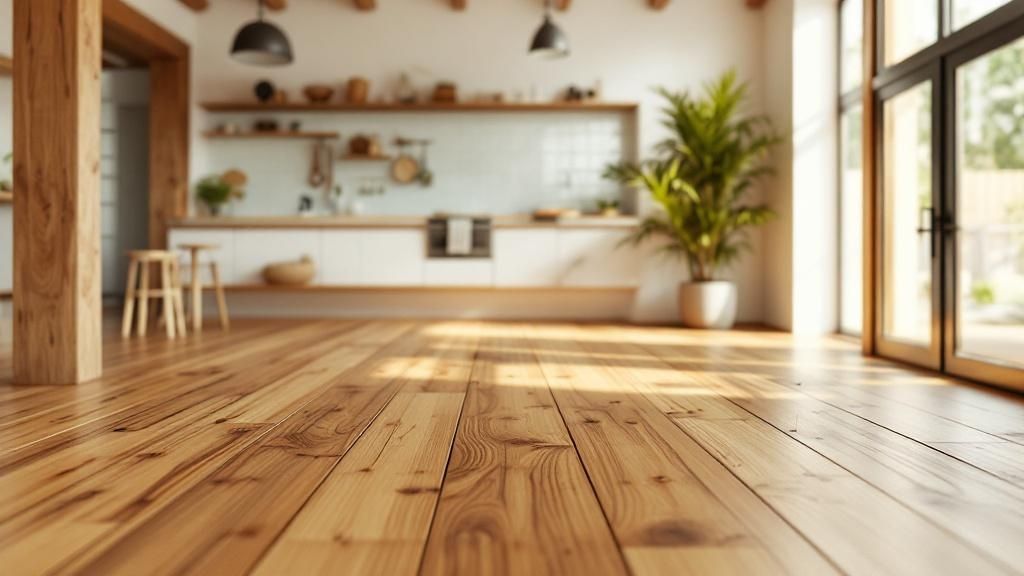
(Caption: A modern, sustainably designed building featuring large windows and natural materials, reflecting future trends in construction.)
The world of sustainable building is always moving forward. It’s driven by new tech that promises to make our structures more efficient. For builders and architects here in the Bay Area, keeping up is about building smarter, faster, and staying competitive.
These are the tools and ideas shaping the next generation of high-performance homes. Things like advanced solar energy solutions are a great example, where technology is becoming part of the building itself, not just an add-on.
Smart Buildings and The Internet of Things (IoT)
One of the biggest shifts is happening inside buildings. Today’s structures are getting smarter, using technology to actively manage their own performance. This is where AI and the Internet of Things (IoT) are making a huge impact.
Imagine a building management system that automatically dims lights, adjusts the HVAC, and even checks the weather forecast. A commercial building in San Francisco, for instance, can use its AI to pre-cool offices during cheaper, off-peak morning hours. This simple move slashes its energy bill during the peak afternoon rush.
The Rise of Modular and Prefabricated Construction
Another huge leap forward is happening away from the job site. Modular and prefabricated construction is the process of building entire sections of a structure in a factory. These completed modules are then shipped to the site and assembled.
Building in a factory gives you incredible precision, leading to tighter building envelopes and better energy performance. It also slashes construction waste and shaves time off project schedules. Pair that with top-tier components and you have a powerful recipe for quality and sustainability. Our guide to energy-efficient windows for Bay Area homes is a great place to see how high-performance parts fit into this picture.
Designing for a Circular Economy
Perhaps the most forward-thinking idea is the shift to a circular economy in construction. For decades, our model has been linear: take, build, and throw away. The circular approach flips that by aiming to eliminate waste completely.
The key is designing for deconstruction. This means thinking about the building's end-of-life from the start. How can we assemble this so its parts can be easily taken apart, salvaged, and reused in another project?
A few ways to do this include:
- Using screws and bolts instead of permanent glues and adhesives.
- Creating a "material passport" that catalogues every component for future recovery.
- Choosing durable, high-quality materials that will hold their value for a second or third life.
Adopting this mindset puts builders at the leading edge of the industry. It's about seeing buildings not as disposable products but as valuable banks of materials for the future. You can read more about these industry trends to see just how crucial collaboration has become.
Navigating Bay Area Green Building Codes and Certifications
For any builder in the Bay Area, getting a handle on local regulations isn’t just good practice—it's essential for a successful project. These codes and certifications are the practical frameworks that bring sustainable building principles to life on the job site.
It's best to think of these standards as proven playbooks for excellence. Mastering these rules is a key part of building responsibly in our region.
The Two Pillars of California Green Building
Here in California, sustainable construction is written into the code. Two major statewide mandates set the baseline for energy performance and green practices for every new build and major remodel from San Francisco to Oakland.
- California Title 24: Often just called the Energy Code, this is the state’s mandatory energy efficiency standard. It covers everything from insulation levels and window U-factors to HVAC performance.
- CALGreen Code: This was the nation's first mandatory green building standards code. It goes beyond energy to tackle water conservation, waste reduction, material selection, and indoor air quality.
These two codes work together to ensure all new construction meets a high bar for sustainability. According to the California Energy Commission, buildings compliant with Title 24 use significantly less energy, saving homeowners money and reducing strain on our power grid.
Voluntary Certifications: The Gold Standard of Green Building
While Title 24 and CALGreen set the mandatory floor, many projects aim higher by pursuing voluntary certifications. These programs act as a mark of exceptional quality, signaling that a building has achieved a superior level of sustainability.
A voluntary certification like LEED is more than a plaque on the wall. It’s a verifiable testament to a project's commitment to health and efficiency, often leading to higher property values.
Two of the most respected certification systems are:
- LEED (Leadership in Energy and Environmental Design): This is the most recognized green building rating system in the world. LEED provides a framework for creating healthy, highly efficient green buildings, with certification levels of Certified, Silver, Gold, or Platinum.
- Living Building Challenge (LBC): This is one of the most rigorous standards out there. The LBC envisions a future where buildings are regenerative—they give more back to the environment than they take.
Achieving these certifications takes careful planning. Exploring options for high-performance windows and doors in the San Francisco Bay Area is a great place to start, as the right products are critical for meeting these stringent requirements.
Your Sustainable Building Partner in the Bay Area
Knowing the basics of sustainable building is one thing; turning that knowledge into a successful project is another. Across the Bay Area, green construction offers tangible benefits, from enhancing property values in San Francisco to slashing operating costs in Oakland. It's about building smarter to create healthier, more resilient homes.
That journey from blueprint to reality demands more than just the right materials—it requires deep expertise. Here at Truitt & White, think of us as your dedicated partner in green construction, ready to translate complex principles into practical solutions for your project.
From Blueprint to Building with Expert Guidance
Whether you’re taking on a remodel or starting from the ground up, our team is here to offer personalized guidance. We’ll help you navigate product selection, ensuring your materials match your design vision and meet the Bay Area’s stringent building codes.
The push for greener construction is a global movement. A recent survey found that 69% of industry stakeholders now consider sustainable practices a top priority. As builders and architects drive this change, having a knowledgeable local partner becomes invaluable.
Let’s Build a More Sustainable Future Together
Putting these green building concepts into practice starts with a conversation. We invite you to connect with our team of specialists for expert advice tailored to your project's unique challenges and goals.
Here’s a look at our easy-to-use contact page, your direct line to our experts.
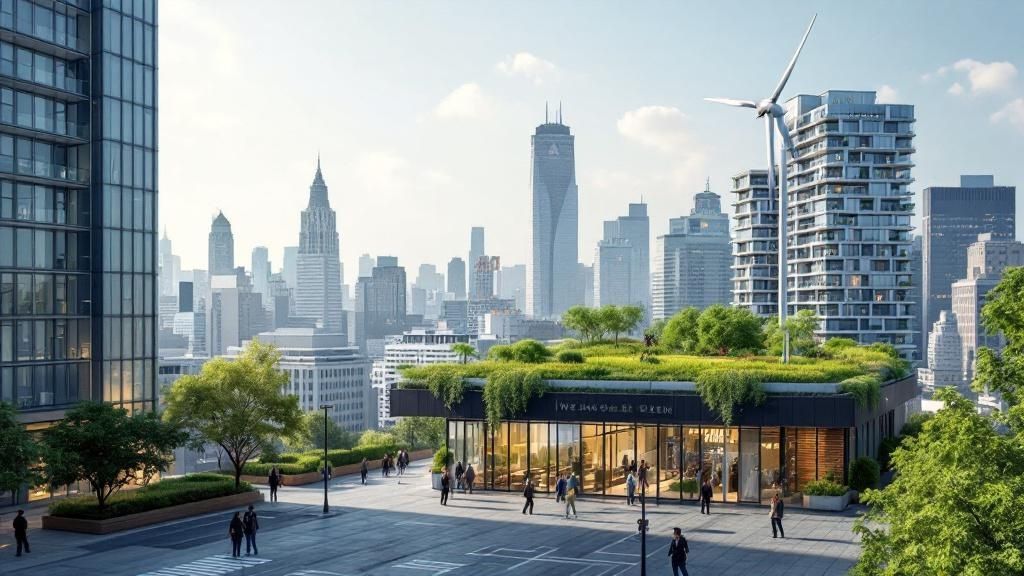
(Caption: Truitt & White's online contact form, allowing builders and homeowners to easily connect with specialists for their project needs.)
The form lets you get right to the point, so we can connect you with the right specialist from the start.
Your project deserves a partner who shares your commitment to quality and sustainability. We encourage you to connect with us online to get started. Let’s work together to build a better Bay Area.
Frequently Asked Questions About Sustainable Building
Here are answers to some of the most common questions we hear from builders, architects, and homeowners in the Bay Area. For even more information, you can always check out our main Truitt & White FAQ page.
Is sustainable building more expensive than traditional construction?
Initially, some high-performance materials may have a higher upfront cost. However, a well-designed sustainable home leads to significant long-term savings through lower energy and water bills, reduced maintenance, and often a higher resale value, especially in the Bay Area market.
Can I apply sustainable principles to a home remodel?
Absolutely. A remodel is a perfect opportunity to make your home healthier and more efficient. Upgrades like installing high-performance Bay Area windows and doors, adding insulation, or using low-VOC paints can have a major impact on performance and comfort.
What is the most important first step for a sustainable project?
The single most critical step is integrated design. This means getting your entire team—the architect, builder, and engineers—together from day one to set clear sustainability goals. It is far more effective and affordable to plan for performance from the beginning.
How does California's Title 24 code relate to sustainable building?
California's Title 24 Energy Standards are the backbone of sustainable building in our state. The code sets a high, mandatory bar for energy efficiency in all new construction and major remodels. Complying with Title 24 is the foundational first step toward creating a truly sustainable building in California.
Where can I find sustainable building materials in the Bay Area?
Work with a knowledgeable local supplier like Truitt & White. We specialize in sourcing a wide variety of green building materials, from FSC-certified lumber and reclaimed wood to high-performance insulation and low-VOC finishes from a convenient lumberyard near Oakland. Our team can help you find the right products to meet your project goals and California’s building codes.
What are the benefits of energy-efficient windows in the Bay Area?
In our temperate climate, high-performance windows are crucial. They prevent heat loss in the winter and block solar heat gain in the summer, which significantly reduces heating and cooling costs. This improves indoor comfort year-round and helps meet California’s strict Title 24 energy requirements.
At Truitt & White, we’re more than just a supplier; we're your partner in building a better, more sustainable Bay Area. Visit our Berkeley showroom or connect with us online for expert advice on your next project.


